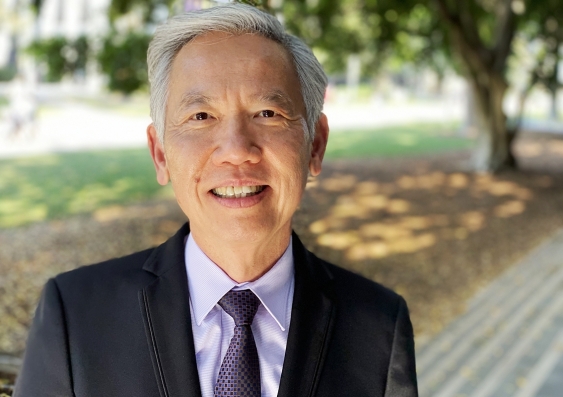After studying at the University of New South Wales (UNSW) in the 1980s and early 90s, Professor Chee Mun Chong returned to campus in 2009 to take up a position at UNSW’s School of Photovoltaic Renewable Energy Engineering (SPREE). The return has proved enormously fruitful, as Chong’s intervening years in the energy industry in Asia ensures he is the best bridge between Australia’s leading photovoltaic school and industry partners.
Chong’s return to SPREE was an illustrious one considering his record of 20.6% efficiency with large-area buried contact solar cells still stood at the time. “I had PhD students who didn’t know my history telling me how much they wanted to break the 20% efficiency record,” remembered Chong. “I just smiled. I didn’t want to discourage them.”
In the 20 years between stints at SPREE, Chong worked high up in the energy industry, such as building business for Exxon Mobil in Asia from his Hong Kong base before the 1997 handover. With the 1997 exodus of ex-pats in Hong Kong, Chong rightly guessed there would be a high demand for talent, a demand he thought to take advantage of.
However, Chong eventually turned his back on such jobs, deciding to return what he says is his most fulfilling role to date: overseeing deals between UNSW and the world’s leading solar cell manufacturers to commercialise SPREE’s advanced hydrogenation technology.
In June pv magazine toured SPREE’s broad array of projects, including its Chong-led hydrogenation group. Advanced hydrogenation, put simply, is the process of introducing a hydrogen atom during the manufacture of solar cells in order to ‘passivate’ the symptoms of dislodging an electron from silicon using sunlight. The passivation ensures as many electrons as possible arrive at their intended destination, an easy boost to operating efficiency that can be made at the manufacturing stage.
As pv magazine observed, Chong’s hydrogenation group is working on a variety of differing projects, from exploring how to control hydrogen in severely defected silicon such as cheap cast-mono wafers, to the other end of the silicon quality spectrum with high-efficiency n-type solar cells. As Chong told pv magazine at the time, “it’s just the beginning for hydrogenation, as we learn to use it in various and more clever ways.”
Chong believes hydrogenation’s future is irrevocably tied to the enormous potential of solar. Moreover, Chong believes his 20 years spent as an energy executive in Asia, making decisions involving 10s of millions of dollars, gives him the requisite decision-making experience to be at the forefront of the solar industry as it takes off.
Earlier this year, Chong facilitated $3 million worth of deals with Chinese energy giant Chint Solar and Aiko Solar. The deals will fund collaborative research for UNSW’s advanced hydrogenation project, building on the already substantial investment from the Australian Renewable Energy Agency (ARENA).
Chong is still chasing new solar efficiency records. “We ended up reducing degradation of solar cells that up until then, was accounting for a 10 to 20% loss of efficiency over the lifetime of the solar cells – usually around 15 to 20 years,” said Chong. “After treating cells with advanced hydrogenation, degradation now only results in a 2% reduction in efficiency over the lifetime of the product.”
Chong isn’t stopping there, he is confident 1% is achievable, even 0.5%. “But for the moment,” continued Chong, “there’s still plenty of research to be done and luckily, our industrial partners are as keen for it as we are.”
If you were wondering, Chong’s solar efficiency record for a large area commercial cell was eventually broken in late 2011 by a UNSW team working in collaboration with Suntech Power.
This content is protected by copyright and may not be reused. If you want to cooperate with us and would like to reuse some of our content, please contact: editors@pv-magazine.com.









By submitting this form you agree to pv magazine using your data for the purposes of publishing your comment.
Your personal data will only be disclosed or otherwise transmitted to third parties for the purposes of spam filtering or if this is necessary for technical maintenance of the website. Any other transfer to third parties will not take place unless this is justified on the basis of applicable data protection regulations or if pv magazine is legally obliged to do so.
You may revoke this consent at any time with effect for the future, in which case your personal data will be deleted immediately. Otherwise, your data will be deleted if pv magazine has processed your request or the purpose of data storage is fulfilled.
Further information on data privacy can be found in our Data Protection Policy.